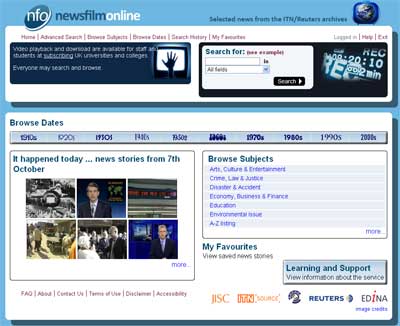NewsFilm Online, launched last week, contains 60,000 digitised clips from the archives of ITN and other news sources.
It’s an incredibly rich resource, featuring news stories relating to events such as the Suez crisis in 1956, Nelson Mandela’s first interview in 1961, the moon landing in 1969 and the death of Diana, Princess of Wales in 1997.
For the moment, it’s fun just exploring some of the content that is there.
But it will be interesting to see how the resources get used in the educational community.
Video has not had a great take up in teaching and learning – is this because of the content, or because of the medium? How NewsFilm Online is used will give us much more evidence in this area.
(Note the videos can only be accessed by those in UK university and college sector.)


One reply on “Yesterdays’s Headlines …. Televised News Online”
Having been involved in the development of the supporting assisted take up materials and practical guidance elements of the project, I agree that the take up of film/video in an educational context is slow; certainly compared with some other walks of life. I think the reason may be manifold. Evidence from the workshops we set up in London Glasgow and York suggests it is not an aversion with the medium itself but perhaps a lack of awareness and the opportunity to engage with high quality resources. There may also be a misconception it is not “suitable for ‘my subject”.
Currently, many of the video resources on the internet are streaming, for example Real Player, in other words – Internet TV. Newsfilm Online differs, in that it allows users to; (easily), download, edit, trim and repurpose the content to suit their learning activities and contexts. There have already been some exceptional and innovative uses of Newsfilm Online demonstrated in our pilot studies. Allied to this the first hand nature of much of the content, (including content never previously shown), reflects our society and culture in ways not possible with other media.
I believe it is essential to promote the resource through communities of practice, and practical workshops, perhaps with a subject focus. The site’s user interface developed by Edina makes engaging with the resource a very rewarding experience. It was indicated at the launch on 3rd October, that the take up by academic institutions is already high, so there is no reason why this should not become a great success story. Finally it is worth mentioning that this resource is not only for students of, say; politics or media but there is something here for everyone.